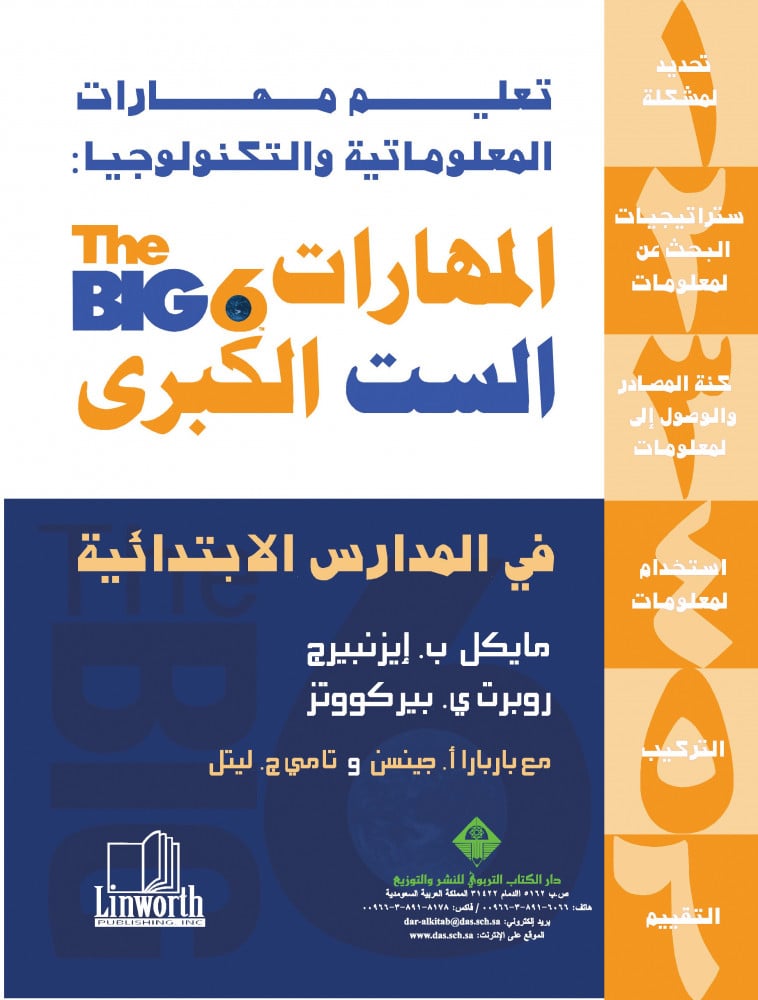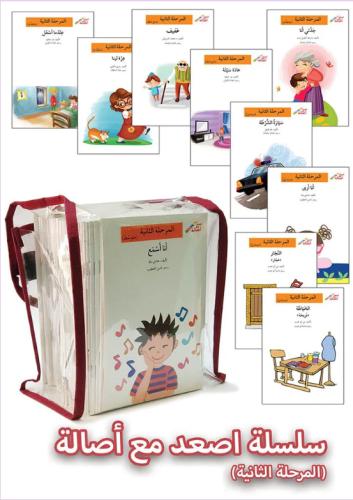AVAILABLE IN ARABIC
About This Book
The Big6™ approach, the most widely known and used information problem-solving model, encourages information-based problem-solving and decision-making skills that empower students and improve literacy. This practical book enables elementary educators, classroom teachers, library media and technology specialists, and administrators to understand and implement the Big6 approach to information and technology skills learning. This book discusses specific techniques, strategies, and ways to build the Big6™ into existing instructional programs. Included are specific Big6 instructional ideas in context, which can be used to modify and meet specific instructional needs. Use the Big6™ to help students develop the skills and understanding they need to find, process, and use information effectively.
Topics : Teaching Strategies
Table Of Content
Part I: Overview of the Big6TM Approach
Chapter 1: Introduction: The Need
The Information Problem
The Big6 and Other Process Models
Teaching and Learning- the Big6
Chapter 2: The Big6 Process and Skills
Levels of the Big6
Level 1: The Conceptual Level
Level 2: The Big6
Level 3: The Big6 Component Skills—The Littlel2
Task Definition
Information Seeking Strategies
Location & Access
Use of Information
Synthesis
Evaluation
The Super3
Summary
Chapter 3: Technology With a Big6 Face
Introduction
Technology and the Big6
Examples of Technology in Big6 Contexts
The Big6 and the Internet
Summary
Chapter 4: Implementing the Big6: Context, Context, Context
Introduction: Contexts
Context 1: The Big6 Process
Context 2: Curriculum
Analyzing Curriculum From a Big6 Perspective
Planning and Plans for the Individual Teacher
Planning and Plans for a Subject Area, Grade, or Team
Planning and Plans on the School Level
Summary
Chapter 5: Assessment of Information & Technology Skills
Introduction
Effectiveness and Efficiency
Forms and Context for Assessment
Ways of Assessing
Evidence
Content Learning Goals
Big6 Learning Goals
Criteria for Judging
A Rating Scale for Judging
The Judgements Themselves
Big6 Scoring Guides
Self-Assessment
Summary
Part II: The Big6 in Action
Introduction
Chapter 6: Big6 #1: Task Definition
Big6 TIPS: Teaching Information Problem-Solving:
Task Definition
- The Big6 Card
- Common Questions
- It's a Problem! Turning Curriculum Objectives Into Problems for Students to Solve
- What Information Do I Need to Do This Task?
- What's the Task?
Chapter 7: Big6 #2: Information Seeking Strategies
Big6 TIPS: Determine and Narrow
- It's an Armadillo
- What Can I Use for This Project?
Teaching Students to Select Resources
- Which is Best? Choosing the Resource for Me
Chapter 8: Big6 #3: Location & Access
Big6 TIPS: Location & Access—Think Index, Keywords, and Boolean
- Beginning, Middle, and End: Using the Alphabet to Introduce the Encyclopedia
- Key to Understanding: Using Keywords and Related Words for Location & Access
- Madeline: Fact or Fiction?
Chapter 9: Big6 #4: Use of Information
Big6 TIPS: Use, of Information—Where the Rubber Meets the Road
- Big6 Buddies
- Science and the Big6
- "Trash-N-Treasure" Approach to Note-Taking
Chapter 10: Big6 #5: Synthesis
Big6 TIPS: Synthesis—Putting It All Together
- Celebrate 100th Day
- Memorable Summer Moment...What I Did on My Summer Vacation With a New Twist
- Presentation Pick: What's the Best Way to Present the Results of My Information Search?
- Writing Physical Education Curriculum
Chapter 11: Big6 #6: Evaluation
Big6 TIPS: Evaluation—Ensuring Effectiveness and Efficiency
- Big6' Assessment Activity: Ask & Answer
- Bubbles, Evaluation: What Items Will Make Good Bubble Blowing Devices?
- Self-Evaluation
- What Did I Learn? (graphic evaluation)
- Big6 Number Six—Evaluation
Chapter 12: The Super3
TIPS for Introducing the "Super3" So . . . What About Working With the Very Youngest?
- Super3 Hints from Other Educators
- Curious George and the Super3
Chapter 13: Closing
The Pervasive Big6
Summary
Appendix
Appendix A: Comparison of Information Skills Process Models Appendix B: Big6 Song by Barbara A. Jansen
References
Index
About the Authors
Micheal B. Eisenberg:

Michael Eisenberg is an attorney in Holland & Knight's New York office. His practice focuses on all types of intellectual property (IP) litigation. He has particular experience in patent, copyright and trade secret matters where technical issues rise to the forefront. Of those areas, Mr. Eisenberg focuses most of his time on patent litigation involving semiconductor devices, computer software and telecommunications. Mr. Eisenberg has served, and continues to serve, as lead counsel on numerous litigations in district courts nationwide on behalf of patent owners and defendants.
In addition to his district court experience, Mr. Eisenberg has also gained substantial experience as lead counsel on many post-grant U.S. Patent and Trademark Office proceedings. That experience has included matters on behalf of patent owners and defendants. Indeed, his record of success in those proceedings has included final decisions on behalf of petitioners as well as institution denials on behalf of patent owners.
In addition to his legal practice, Mr. Eisenberg served as a clerk to the Honorable Timothy Dyk of the U.S. Court of Appeals for the Federal Circuit.
Robert E. Berkowitz:

Robert E. Berkowitz is Director of IT Strategy at The Clorox Company. Robert is responsible for managing the intersection of our IT and business strategy overseeing the development and execution of the IT annual strategy and long range plan. Robert has over 20 years of technology experience working in start-ups to large enterprises in a variety of IT roles.
Robert began his career as a programmer developing network management and security solutions. He has held various other leadership roles throughout his career. At Lenovo he grew and managed a global IT vendor management team and lived and worked in Beijing on international assignment. Robert also has extensive mergers and acquisitions experience being responsible for IT due-diligence and integration planning on a number of global deals including Lenovo’s acquisition of Motorola and IBM x86 server divisions (valued at over $2B USD combined).
Originally from Pittsburgh PA, Robert lives in Chapel Hill, North Carolina. He earned a bachelor’s degree in computer information systems from Kent State University. He is married and has three children.
- ISBN: 9960863301
- Author: Michael B. Eisenberg & Robert E. Berkowitz
- Publisher: Educational Book House
- Size: 21.5*28cm
- Pages number: 162













